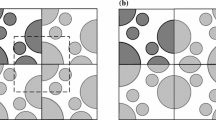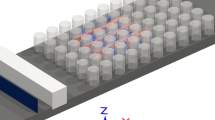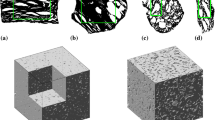Abstract
The direct proportionality between the flow rate and the pressure gradient of creeping flows was experimentally discovered by H. Darcy in the 19th century and theoretically justified a couple of decades ago using upscaling methods such as volume averaging or homogenization. X-ray computed micro-tomography (CMT) and pore-scale numerical simulations are increasingly used to estimate the permeability of porous media. However, the most general case of non-periodic anisotropic porous media still needs to be completely numerically defined. Pore-scale numerical methods can be split into two families. The first family is based on a direct resolution of the flow solving the Navier–Stokes equations under the assumption of creeping flow. The second one relies on the resolution of an indirect problem—such as the closure problem derived from the volume averaging theory. They are known to provide the same results in the case of periodic isotropic media or when dealing with representative element volumes. To address the most general case of non-periodic anisotropic porous media, we have identified four possible numerical approaches for the first family and two for the second. We have compared and analyzed them on three-dimensional generated geometries of increasing complexity, based on sphere and cylinder arrangements. Only one, belonging to the first family, has been proved to remain rigorously correct in the most general case. This has been successfully applied to a high-resolution 3D CMT of Carcarb, a carbon fiber preform used in the thermal protection systems of space vehicles. The study concludes with a detailed analysis of the flow behavior (streamlines and vorticity). A quantitative technique based on a vorticity criterion to determine the characteristic length of the material is proposed. Once the characterized length is known, the critical Reynolds number can be estimated and the physical limit of the creeping regime identified.
















Similar content being viewed by others
Notes
The computation of the permeability is based on Monte Carlo simulations.
The vorticity equation has been derived by taking the curl of the transient momentum equation.
For the moment the method is based on a qualitative analysis of the vorticity field. More analysis with different geometries should be performed to make the analysis more rigorous.
Abbreviations
- \(\underline{\underline{\varvec{K}}}\) :
-
Permeability tensor \([m^2]\)
- \(\underline{\underline{\varvec{d}}}\) :
-
Velocity deviation tensor \([m \hspace{1mm} s^{-1}]\)
- \(\underline{\underline{\varvec{I}}}\) :
-
Identity tensor
- \(\varvec{e}\) :
-
Pressure deviation term [Pa]
- \(\varvec{r}\) :
-
Position vector [m]
- \(\varvec{U}\) :
-
Darcy-scale velocity \([m \hspace{1mm} s^{-1}]\)
- \(\varvec{u}\) :
-
Pore-scale velocity \([m \hspace{1mm} s^{-1}]\)
- \(\varvec{w}\) :
-
Pore-scale vorticity \([s^{-1}]\)
- A :
-
Interface area \([m^2]\)
- c :
-
Artificial compressibility coefficient \([m^{1/2} s^{-1/2}]\)
- \(\ell\) :
-
Reference length [m]
- N :
-
Total number of values predicted by the strategies
- P :
-
Darcy-scale pressure [Pa]
- p :
-
Pore-scale pressure [Pa]
- V :
-
Volume \([m^3]\)
- \(\delta\) :
-
Thickness of the lateral fluid layer used in strategies B and D [m]
- \(\epsilon\) :
-
Porosity of the medium
- \(\theta\) :
-
Rotation angle
- \(\mu\) :
-
Dynamic viscosity \([Pa \hspace{1mm} s]\)
- \(\rho\) :
-
Pore-scale density \([kg \hspace{1mm} m^{-3}]\)
- \(\nu\) :
-
Kinematic viscosity \([m^2 s^{-1}]\)
- \(*\) :
-
Non-dimensional variable
- \(\sim\) :
-
Deviation term
- art:
-
Artificial
- avg:
-
Average
- cl:
-
Cluster
- dg:
-
Diagonal
- f :
-
Fluid
- s :
-
Solid
- CMT:
-
Computed Micro-Tomography
- PATO:
-
Porous material Analysis Toolbox based on OpenFoam
- REV:
-
Representative Element Volume
- Re :
-
Reynolds number
References
Agnaou, M., Lasseux, D., Ahmadi, A.: Origin of the inertial deviation from darcy’s law: an investigation from a microscopic flow analysis on two-dimensional model structures. Phys. Rev. E 96(4), 043105 (2017)
Ahrens, J., Geveci, B., Law, C.: Paraview: an end-user tool for large data visualization. Vis. Handb. 717 (2005)
Ali, M., Umer, R., Khan, K., Cantwell, W.: Application of x-ray computed tomography for the virtual permeability prediction of fiber reinforcements for liquid composite molding processes: A review. Compos. Sci. Technol. 184, 107828 (2019)
Almedeij, J.: Drag coefficient of flow around a sphere: matching asymptotically the wide trend. Powder Technol. 186(3), 218–223 (2008)
Andrä, H., Combaret, N., Dvorkin, J., Glatt, E., Han, J., Kabel, M., Keehm, Y., Krzikalla, F., Lee, M., Madonna, C., et al.: Digital rock physics benchmarks-part i: imaging and segmentation. Comput. Geosci. 50, 25–32 (2013)
Anguy, Y., Bernard, D., Ehrlich, R.: The local change of scale method for modelling flow in natural porous media (i): numerical tools. Adv. Water Resour. 17(6), 337–351 (1994)
Antohe, B., Lage, J., Price, D., Weber, R.: Experimental determination of permeability and inertia coefficients of mechanically compressed aluminum porous matrices (1997)
Ashari, A., Bucher, T., Tafreshi, H.V.: A semi-analytical model for simulating fluid transport in multi-layered fibrous sheets made up of solid and porous fibers. Comput. Mater. Sci. 50(2), 378–390 (2010)
Bagheri, G., Bonadonna, C.: On the drag of freely falling non-spherical particles. Powder Technol. 301, 526–544 (2016)
Barrere, J., Gipouloux, O., Whitaker, S.: On the closure problem for darcy’s law. Transp. Porous Media 7(3), 209–222 (1992)
Bernard, D., Nielsen, Ø., Salvo, L., Cloetens, P.: Permeability assessment by 3d interdendritic flow simulations on microtomography mappings of al-cu alloys. Mater. Sci. Eng., A 392(1–2), 112–120 (2005)
Bodla, K., Murthy, J., Garimella, S.: Microtomography-based simulation of transport through open-cell metal foams. Numer. Heat Transf. Part A Appl. 58(7), 527–544 (2010)
Borner, A., Panerai, F., Mansour, N.: High temperature permeability of fibrous materials using direct simulation monte carlo. Int. J. Heat Mass Transf. 106, 1318–1326 (2017)
(Brochure), M.: Calcarb rigid carbon thermal insulation (2017). Https://www.mersen.com/sites/default/files/publications-media/3-gs-calcarb-grade-cbcf-18-2000-mersen.pdf
Chamsri, K., Bennethum, L.: Permeability of fluid flow through a periodic array of cylinders. Appl. Math. Model. 39(1), 244–254 (2015)
Cushman, J., Bennethum, L., Hu, B.: A primer on upscaling tools for porous media. Adv. Water Resour. 25(8–12), 1043–1067 (2002)
Davy, C., Adler, P.: Three-scale analysis of the permeability of a natural shale. Phys. Rev. E 96(6), 063116 (2017)
Derossi, A., Gerke, K., Karsanina, M., Nicolai, B., Verboven, P., Severini, C.: Mimicking 3d food microstructure using limited statistical information from 2d cross-sectional image. J. Food Eng. 241, 116–126 (2019)
Dybbs, A., Edwards, R.: A new look at porous media fluid mechanics-darcy to turbulent. In: Fundamentals of transport phenomena in porous media, pp. 199–256. Springer (1984)
Dyck, N., Straatman, A.: A new approach to digital generation of spherical void phase porous media microstructures. Int. J. Heat Mass Transf. 81, 470–477 (2015)
Forchheimer, P.: Wasserbewegung durch boden. Z. Ver. Deutsch Ing. 45, 1782–1788 (1901)
Gerke, H.: Preferential flow descriptions for structured soils. J. Plant Nutr. Soil Sci. 169(3), 382–400 (2006)
Gerke, K., Karsanina, M., Katsman, R.: Calculation of tensorial flow properties on pore level: exploring the influence of boundary conditions on the permeability of three-dimensional stochastic reconstructions. Phys. Rev. E 100(5), 053312 (2019)
Gerke, K., Karsanina, M., Skvortsova, E.: Description and reconstruction of the soil pore space using correlation functions. Eurasian Soil Sci. 45(9), 861–872 (2012)
Gerke, K., Korost, D., Vasilyev, R., Karsanina, M., Tarasovskii, V.: Studying structure and determining permeability of materials based on x-ray microtomography data (using porous ceramics as an example). Inorg. Mater. 51(9), 951–957 (2015)
Gerke, K.M., Sizonenko, T.O., Karsanina, M.V., Lavrukhin, E.V., Abashkin, V.V., Korost, D.V.: Improving watershed-based pore-network extraction method using maximum inscribed ball pore-body positioning. Adv. Water Resour. 140, 103576 (2020)
Gerke, K.M., Vasilyev, R.V., Khirevich, S., Collins, D., Karsanina, M.V., Sizonenko, T.O., Korost, D.V., Lamontagne, S., Mallants, D.: Finite-difference method stokes solver (fdmss) for 3d pore geometries: Software development, validation and case studies. Comput. Geosci. 114, 41–58 (2018)
Gray, W.: A derivation of the equations for multi-phase transport. Chem. Eng. Sci. 30(2), 229–233 (1975)
Guibert, R., Horgue, P., Debenest, G., Quintard, M.: A comparison of various methods for the numerical evaluation of porous media permeability tensors from pore-scale geometry. Math. Geosci. 48(3), 329–347 (2016)
Haussener, S., Coray, P., LipiĹ, W., Wyss, P., Steinfeld, A., et al.: Tomography-based heat and mass transfer characterization of reticulate porous ceramics for high-temperature processing. J. Heat Transfer 132(2), 023305 (2010)
Issa, R.: Solution of the implicitly discretised fluid flow equations by operator-splitting. J. Comput. Phys. 62(1), 40–65 (1986)
Jaganathan, S., Tafreshi, H.V., Pourdeyhimi, B.: Two-scale modeling approach to predict permeability of fibrous media. J. Eng. Fibers Fabr. 3(2), 155892500800300220 (2008)
Jobic, Y., Kumar, P., Topin, F., Occelli, R.: Determining permeability tensors of porous media: a novel ‘vector kinetic’numerical approach. Int. J. Multiph. Flow 110, 198–217 (2019)
Khan, Z.A., Elkamel, A., Gostick, J.T.: Efficient extraction of pore networks from massive tomograms via geometric domain decomposition. Adv. Water Resour. 145, 103734 (2020)
Kumar, P., Topin, F.: Investigation of fluid flow properties in open cell foams: Darcy and weak inertia regimes. Chem. Eng. Sci. 116, 793–805 (2014)
Lachaud, J., Mansour, N.: Porous-material analysis toolbox based on openfoam and applications. J. Thermophys. Heat Transfer 28(2), 191–202 (2014)
Lachaud, J., Meurisse, J.: Http://pato.ac/
Lachaud, J., Scoggins, J., Magin, T., Meyer, M., Mansour, N.: A generic local thermal equilibrium model for porous reactive materials submitted to high temperatures. Int. J. Heat Mass Transf. 108, 1406–1417 (2017)
Landis, E., Keane, D.: X-ray microtomography. Mater. Charact. 61(12), 1305–1316 (2010)
Liakopoulos, A.: Darcy’s coefficient of permeability as symmetric tensor of second rank. Hydrol. Sci. J. 10(3), 41–48 (1965)
Manwart, C., Aaltosalmi, U., Koponen, A., Hilfer, R., Timonen, J.: Lattice-boltzmann and finite-difference simulations for the permeability for three-dimensional porous media. Phys. Rev. E 66(1), 016702 (2002)
Masad, E., Al Omari, A., Chen, H.C.: Computations of permeability tensor coefficients and anisotropy of asphalt concrete based on microstructure simulation of fluid flow. Comput. Mater. Sci. 40(4), 449–459 (2007)
Mikhailov, M., Freire, A.: The drag coefficient of a sphere: an approximation using shanks transform. Powder Technol. 237, 432–435 (2013)
Moreira, E., Innocentini, M., Coury, J.: Permeability of ceramic foams to compressible and incompressible flow. J. Eur. Ceram. Soc. 24(10–11), 3209–3218 (2004)
Mustard, J., Adler, M., Allwood, A., Bass, D., Beaty, D., Bell, J., Brinckerhoff, W., Carr, M., Des Marais, D., Brake, B., et al.: Report of the mars 2020 science definition team. Mars Explor. Progr. Anal. Gr 150, 155–205 (2013)
Panerai, F., Ferguson, J., Lachaud, J., Martin, A., Gasch, M., Mansour, N.: Micro-tomography based analysis of thermal conductivity, diffusivity and oxidation behavior of rigid and flexible fibrous insulators. Int. J. Heat Mass Transf. 108, 801–811 (2017)
Panerai, F., White, J., Cochell, T., Schroeder, O., Mansour, N., Wright, M., Martin, A.: Experimental measurements of the permeability of fibrous carbon at high-temperature. Int. J. Heat Mass Transf. 101, 267–273 (2016)
Patankar, S., Spalding, D.: A calculation procedure for heat, mass and momentum transfer in three-dimensional parabolic flows. In: Numerical prediction of flow, heat transfer, turbulence and combustion, pp. 54–73. Elsevier (1983)
Petrasch, J., Meier, F., Friess, H., Steinfeld, A.: Tomography based determination of permeability, dupuit-forchheimer coefficient, and interfacial heat transfer coefficient in reticulate porous ceramics. Int. J. Heat Fluid Flow 29(1), 315–326 (2008)
Pickup, G., Ringrose, P., Jensen, J., Sorbie, K.: Permeability tensors for sedimentary structures. Math. Geol. 26(2), 227–250 (1994)
Piller, M., Schena, G., Nolich, M., Favretto, S., Radaelli, F., Rossi, E.: Analysis of hydraulic permeability in porous media: from high resolution x-ray tomography to direct numerical simulation. Transp. Porous Media 80(1), 57 (2009)
Quintard, M.: Introduction to heat and mass transport in porous media. Porous media interaction with high temperature and high speed ows, STO-AVT-261. VKI p. 33 (2015)
Ranut, P., Nobile, E., Mancini, L.: High resolution microtomography-based cfd simulation of flow and heat transfer in aluminum metal foams. Appl. Therm. Eng. 69(1–2), 230–240 (2014)
Renard, P., Genty, A., Stauffer, F.: Laboratory determination of the full permeability tensor. J. Geophys. Res. Solid Earth 106(B11), 26443–26452 (2001)
Rocha, R., Cruz, M.: Calculation of the permeability and apparent permeability of three-dimensional porous media. Transp. Porous Media 83(2), 349–373 (2010)
Sahimi, M.: Flow and Transport in Porous Media and Fractured Rock: From Classical Methods to Modern Approaches. John Wiley & Sons, Amsterdam (2011)
module by Simpleware, F.: Http://www.simpleware.com/
Soulaine, C., Gjetvaj, F., Garing, C., Roman, S., Russian, A., Gouze, P., Tchelepi, H.: The impact of sub-resolution porosity of x-ray microtomography images on the permeability. Transp. Porous Media 113(1), 227–243 (2016)
Stackpoole, M., Sepka, S., Cozmuta, I., Kontinos, D.: Post-flight evaluation of stardust sample return capsule forebody heatshield material. In: 46th AIAA Aerospace Sciences Meeting and Exhibit, p. 1202 (2008)
Straatman, A., Gallego, N., Yu, Q., Betchen, L., Thompson, B.: Forced convection heat transfer and hydraulic losses in graphitic foam. J. Heat Transfer 129(9), 1237–1245 (2007)
Tranter, T., Gostick, J., Burns, A., Gale, W.: Capillary hysteresis in neutrally wettable fibrous media: a pore network study of a fuel cell electrode. Transp. Porous Media 121(3), 597–620 (2018)
Valvatne, P.H., Blunt, M.J.: Predictive pore-scale modeling of two-phase flow in mixed wet media. Water resources research 40(7) (2004)
Van Doormaal, M., Pharoah, J.: Determination of permeability in fibrous porous media using the lattice boltzmann method with application to pem fuel cells. Int. J. Numer. Meth. Fluids 59(1), 75–89 (2009)
Vu, J., Straatman, A.: Comparison of pore-level and volume-averaged computations in highly conductive spherical-void-phase porous materials. Transp. Porous Media 124(2), 509–531 (2018)
Whitaker, S.: Flow in porous media i: a theoretical derivation of darcy’s law. Transp. Porous Media 1(1), 3–25 (1986)
Whitaker, S.: The forchheimer equation: a theoretical development. Transp. Porous Media 25(1), 27–61 (1996)
Whitaker, S.: The Method of Volume of Averaging, vol. 13. Springer Science & Business Media, Berlin (2013)
Wiegmann, A.: Computation of the permeability of porous materials from their microstructure by fff-stokes. Bericht des Fraunhofer ITWM 129 (2007)
Wood, B., He, X., Apte, S.: Modeling turbulent flows in porous media. Annu. Rev. Fluid Mech. 52, 171–203 (2020)
Wright, M., Beck, R., Edquist, K., Driver, D., Sepka, S., Slimko, E., Willcockson, W.: Sizing and margins assessment of mars science laboratory aeroshell thermal protection system. J. Spacecr. Rocket. 51(4), 1125–1138 (2014)
Xiong, Q., Joseph, C., Schmeide, K., Jivkov, A.: Measurement and modelling of reactive transport in geological barriers for nuclear waste containment. Phys. Chem. Chem. Phys. 17(45), 30577–30589 (2015)
Acknowledgements
The research of H.S. was sponsored by a PhD grant awarded by Arts et Métiers Institute of Technology.
Author information
Authors and Affiliations
Corresponding author
Ethics declarations
Conflict of interest
The authors declare that they have no conflict of interest.
Additional information
Publisher's Note
Springer Nature remains neutral with regard to jurisdictional claims in published maps and institutional affiliations.
Appendices
Appendix 1: Remarks on the Volume Averaging Method
This appendix has the only purpose to introduce the concepts of the volume averaging method used in this article. Further details can be found in the literature Whitaker (2013).
The volume averaging is a technique used to derive continuum-macroscopic equations for multiphase systems. In this way, the complexity of a porous medium is replaced with an equivalent porous-continuum model in which each point is characterized by the properties of a representative elementary volume (REV) centered on it. Within this, REV variables can be averaged. Two different definitions of averages have been adopted: the phase average which in this article has been used for the pressure term
and the intrinsic average used for the velocity field
Inside the REV, each variable can be decomposed (Gray’s decomposition Gray (1975)) as the summation of its average plus a deviation contribution. For the pressure field, this decomposition is as follows
Appendix 2: KclosureSolver
KclosureSolver is a solver implemented in PATO to solve the closure problem Eq. (20). By following the work of Anguy and Bernanrd, (1994) Anguy et al. (1994), transients terms have been added to the system to improve its stability. The desired solution is taken at the steady state. An artificial compressibility, c, and an artificial viscosity coefficient, \(\mu _{art}\), are also introduced. The modified transient problem is as follows
The two equations are solved sequentially. Each equation can be iterated in a loop. The time integration is carried out through an implicit scheme.
Appendix 3: Mesh Convergence Test Cases
In Sect. 3, numerical simulations on six test cases are presented. The mesh refinement has been selected after a convergence analysis. By considering the 1-sphere unit cell with porosity \(\epsilon = 0.55\), results of the convergence study with strategy A1 are presented in Table 6.
The error% is evaluated taking into account the permeability estimation of two consecutive simulations as follows
The quantity \(V_{ratio}\) is the ratio between the volume of the biggest cell in the domain and the domain itself. From the results in the table, we can see that the convergence of the mesh is immediately achieved since the error is always decreasing by increasing the refinement. This trend, however, should stop when the tolerances of the simulation are reached. That is what happens in the table for the most refined meshes. The resolution of the mesh with 233039-cells can be then selected for the analysis in Sect. 3.
Rights and permissions
About this article
Cite this article
Scandelli, H., Ahmadi-Senichault, A., Levet, C. et al. Computation of the Permeability Tensor of Non-Periodic Anisotropic Porous Media from 3D Images. Transp Porous Med 142, 669–697 (2022). https://doi.org/10.1007/s11242-022-01766-8
Received:
Accepted:
Published:
Issue Date:
DOI: https://doi.org/10.1007/s11242-022-01766-8




